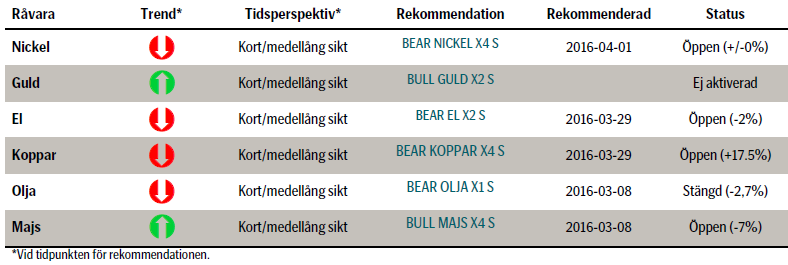Analys
SEB Råvarubrev 12 april 2016

 Risk för oljevolatilitet!
Risk för oljevolatilitet!
MARKNADEN I KORTHET
En relativt mixad vecka med uppgång i oljepriset men nedgång i industrimetallerna. Börserna var slagiga men slutade veckan på minussidan. Innevarande vecka bör bjuda på en del oljevolatilitet givet både ett antal rapporter samt söndagens ”frysningsmöte” i Doha.
Råvaror: Den australienska regeringen har höjt sin prognos avseende priset på järnmalm (är det värsta över?) och räknar med att högkostnadsproducenter slås ut under kommande år (detsamma är ju giltigt för många av metallerna). Oljeinvesteringarna fortsätter att minska, denna gång rapporteras det att Kanada räknar i år med en 62 % nedgång av investeringarna i energisektorn jämfört med rekordåret 2014. Kommer oljeproducenterna överens om en ”frysning”? Och har den i sådana fall någon bestående betydelse? Många länder kommer nog även framgent att vilja pumpa så mycket det bara går för att täcka de uppkomna budgetunderskotten. T.ex. Saudiarabien behöver ett oljepris på cirka $118/fat för att få ihop statsfinanserna.
Valuta: Dollarn har mest stått och stampat förutom mot en del utvecklingsvalutor och framför allt mot den japanska yenen där dollarn tappat ordentligt med mark (vi tror på mer yen-styrka och den kortsiktige kan fundera på BULL JPYSEK X4 S).
Börser: USA gick i och med Alcoa igår in i rapportsäsongen för kvartal ett. Banksektorn har fortsatt att vara ett sänke. Vår vy är att de kommande veckorna kan vara lite slagigare än vad vi sett tidigare under våren.
Räntor: Obligationsränteuppgångarna i Portugal, Spanien och Italien indikerar ökad oro i området.
OBSERVATIONER I SAMMANDRAG
- Trots brottet ned ur den månadslånga konsolideringen lyckades marknaden inte ta sig ner ur den stigande kanalen. Troligen en ny topp innan nästa korrektionsförsök.
- Elpriset har gjort ett första försök att sätta en korrektionstopp på plats.
- Koppar har sedan förra veckan fallit under stödet vid $4720/t så mer nedåtpress förväntas,
- Nickelprisets nedgång har varit mycket långsammare än vad vi trott.
- Den japanska yenens styrka fortsätter att överraska prognosmakarna.
- Guldet har trots ett antal test av 50d medelvärdet lyckats stanna ovanför detta. Hur länge till?
- Majspriset har repat sig och det trots väldigt negativa nyheter. Vi är fortsatt positiva
VECKANS REKOMMENDATIONER
INGEN NY REKOMMENDATION DENNA VECKA.
En placering i certifikat och warranter är förknippat med risker. Du kan förlora hela ditt investerade kapital. Läs mer om riskerna i SEB:s offentliggjorda Grundprospekt för certifikat- och warrantprogram på seb.se/cert eller seb.se/mini
OLJA BRENT
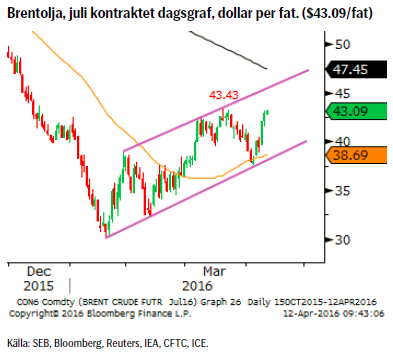 Givet att stödet vid $38,20/fat (kanalgolvet och 50d glidande medelvärde) höll så studsade priset tillbaka upp. Förra veckan avslutades också i dur då priset i princip stängde på fredagens högsta notering.
Givet att stödet vid $38,20/fat (kanalgolvet och 50d glidande medelvärde) höll så studsade priset tillbaka upp. Förra veckan avslutades också i dur då priset i princip stängde på fredagens högsta notering.
Innevarande vecka är antagligen en av de mer betydelsefulla för oljans utveckling i närtid då vi dels får ett antal rapporter under veckan (tisdag EIA, onsdag OPEC och torsdag IEA) och sedan avslutar veckan med oljeproducentmötet i Doha på söndag. Sannolikheten för att en frysning av produktionen skulle lyfta priset signifikant måste anses vara låg. Däremot skulle ett fallissemang sannolikt leda till ett markant lägre pris.
OBSERVATIONER
- Antalet riggar föll förra veckan med åtta stycken (till 354 st.).
- Den amerikanska produktionen fortsätter att falla och bör fortsätta att göra så (EIA prognostiserar att nedgången i maj bör hamna runt 114t fat per dag).
- Saudiarabien säger att det inte blir någon frysning av produktionen om inte Iran deltar i en sådan överenskommelse, något Iran vägrar gå med på innan produktionen nått de nivåer man hade innan sanktionerna trädde i kraft.
- Allt fler prognoser pekar mot en bättre balans under andra halvåret.
- Commitment of Traders (CoT) rapporten visade på en minskning av den långa nettopositionen. Minskningen beror i huvudsak på att andelen korta kontrakt ökade betydligt mer än de långa (börjar tron på högre pris vackla?).
- Det historiska säsongsmönstret pekar mot en pristopp under våren,
- $45.50 (kanaltaket) är veckans huvudmotstånd och $38.86 huvudstödet.
REKOMMENDATION
- Givet osäkerheten för veckan så har vi valt att stänga vår BEAR OLJA X1 S.
EL
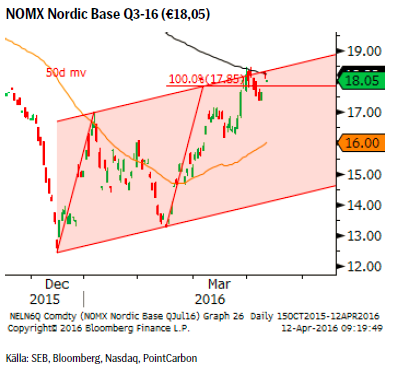 Förra veckan föll priset tillbaka något men stigande oljepriser och utsläppsrätter har ånyo pressat upp priset till den övre delen av vårt estimerade säljområde. Förutom det stigande priset på utsläppsrätter så pekar de flesta fakta mot ett något lägre elpris för kommande vecka.
Förra veckan föll priset tillbaka något men stigande oljepriser och utsläppsrätter har ånyo pressat upp priset till den övre delen av vårt estimerade säljområde. Förutom det stigande priset på utsläppsrätter så pekar de flesta fakta mot ett något lägre elpris för kommande vecka.
OBSERVATIONER
- Befinner sig fortfarande i den övre delen av det utmålade målområdet €17.35 – 18.45.
- Vattenmagasinen har sedan förra veckan fortsatt att minska och har nu en fyllnadsgrad på 39,2%. Fyllnadsgraden bör minska ytterligare då man nu kör för fullt för att ge plats för den kommande vårfloden.
- En anings större nederbörd förväntas under kommande vecka.
- Temperaturen förväntas initialt vara något lägre för att nästa vecka ligga strax över medel.
- Stigande pris på CO2 utsläppsrätter.
- Kanaltaket och 200-dagars medelvärde utgör fortsatt två mycket viktiga tekniska motstånd.
- Skulle priset mot förmodan inte vända i det primära målområdet så återfinns ett sekundärt mål vid €20.66.
REKOMMENDATION
- BEAR EL X2 S
KOPPAR (LME 3M)
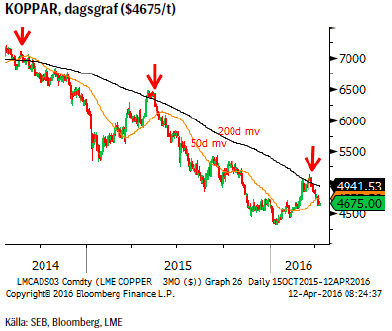 Världskopparkonferensen passerade som förväntat utan några större avtryck i priserna. Överutbudet väntas kvarstå ytterligare något/några år innan vi prognosticeras att hamna i ett strukturellt underskott. Givet de positivare tongångarna på medellång till lång sikt gör att gruvbolagen är ytterst motvilliga att avyttra koppargruvor (om man bara kan överleva de låga (och lägre) priserna i nutid (prognoserna från konferensen pendlar mellan $4,000 till $4,800/t). Dessutom med fallande kinesisk produktion (pga. minskade malmreserver) är signalerna att kinesiska gruvföretag förbereder sig för att köpa upp utländska fyndigheter för att på så sätt säkra framtida tillgång till koppar.
Världskopparkonferensen passerade som förväntat utan några större avtryck i priserna. Överutbudet väntas kvarstå ytterligare något/några år innan vi prognosticeras att hamna i ett strukturellt underskott. Givet de positivare tongångarna på medellång till lång sikt gör att gruvbolagen är ytterst motvilliga att avyttra koppargruvor (om man bara kan överleva de låga (och lägre) priserna i nutid (prognoserna från konferensen pendlar mellan $4,000 till $4,800/t). Dessutom med fallande kinesisk produktion (pga. minskade malmreserver) är signalerna att kinesiska gruvföretag förbereder sig för att köpa upp utländska fyndigheter för att på så sätt säkra framtida tillgång till koppar.
Vi håller kvar vår negativa vy och tror att priset åter bör testa nivåer under $4,560/t.
OBSERVATIONER
- Dollarkorrektionen i sin slutfas?
- Chilenska Codeclo (världens största producent) säger att det finns få signaler om ökad efterfrågan.
- Positioneringen på Comex föll förra veckan (statistik per tisdagens stängning) tillbaka till en netto kort position och givet den negativa prisutvecklingen därefter bör denna ha ökat ytterligare.
- LME inventory rose 1,675 tonnes to 147,350 last week.
- Prisuppgången i år kan inte motiveras av förändrade utbuds/efterfrågekalkyler. Priset måste ned mot eller under $4,000/t innan förlusterna blir stora nog för att tvinga fram mer varaktiga produktionsneddragningar.
- På plussidan har vi de positivare tongångarna från både kinesisk såväl som amerikansk bostadsmarknad.
- Tekniskt så har vi precis återvänt ned under det negativt lutande 200-dagars glidande medelvärdet, precis så som korrektionerna 2014 och 2015 slutade. Förra veckans brott av 50dagars medelvärdet har förstärkt säljsignalen.
REKOMMENDATION
- BEAR KOPPAR X4 S
NICKEL (LME 3M)
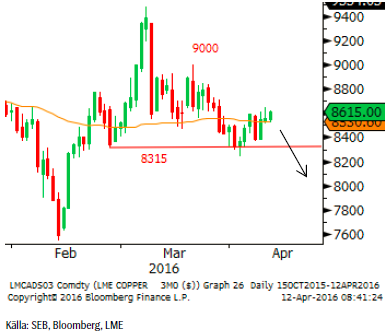 Nickelpriset har inte riktigt utvecklats så som vi tänkt. Brottet under $8315/t borde ha lockat fram mer utbud men så har än så länge inte skett. Kanske är det ändå så att det finns en viss oro givet att vi snabbare än förväntat hamnade i ett underskott. I övrigt så kvarstår de argument som vi tidigare torgfört för lägre priser.
Nickelpriset har inte riktigt utvecklats så som vi tänkt. Brottet under $8315/t borde ha lockat fram mer utbud men så har än så länge inte skett. Kanske är det ändå så att det finns en viss oro givet att vi snabbare än förväntat hamnade i ett underskott. I övrigt så kvarstår de argument som vi tidigare torgfört för lägre priser.
Vi rekommenderar att stänga positionen BEAR NICKEL X4 S om nickelpriset går upp över $8,725/t (den som vill ha en vidare stopp gör detsamma över $9,000).
OBSERVATIONER
- INSG’s (Int’l Nickel Study Group) senaste rapport om ett underskott om 8,100 ton redan i januari indikerar att vi snabbare än förväntat hamnat i underskott.
- Det globala underskottet förväntas att förvärras under kvartal 2 men prisutvecklingen visar dock att marknaden tar underskottet med ro och revideringar av data är antagligen också att förvänta.
- Ytterligare signaler om hur svår pressen på stål och rostfritt stål är (bl.a. strejkade 10-tusentals tyska stålarbetare på måndagen för nya antidumpingregler).
- Planerade, inte genomförda, produktionsneddragningar bör dämpa försök till prisuppgångar.
- Tekniskt sett så har säljsignalen utlösts av brottet av $8,315/t och är giltig tills antingen en ny botten nås alternativt handlar över $9,000/t.
REKOMMENDATION
- BEAR NICKEL X4 S
GULD
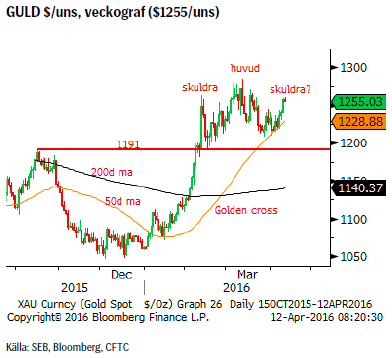 Efter den senaste veckans utveckling bör vi fråga oss huruvida marknaden håller på att skapa en s.k. huvud/skuldra toppformation. Sentimentet är fortsatt väldigt positivt men givet den relativt svaga prisutvecklingen så ser vi det snarare som en varning. Den långa nettopositioneringen är också väldigt stor och historiskt så har nedgångar på 10 – 20% ofta följt vid dessa tillfällen. Vi är dock positiva till ett högre guldpris på lite sikt men anser fortfarande att positioneringen måste ned innan en ny uppgångsfas kan inledas.
Efter den senaste veckans utveckling bör vi fråga oss huruvida marknaden håller på att skapa en s.k. huvud/skuldra toppformation. Sentimentet är fortsatt väldigt positivt men givet den relativt svaga prisutvecklingen så ser vi det snarare som en varning. Den långa nettopositioneringen är också väldigt stor och historiskt så har nedgångar på 10 – 20% ofta följt vid dessa tillfällen. Vi är dock positiva till ett högre guldpris på lite sikt men anser fortfarande att positioneringen måste ned innan en ny uppgångsfas kan inledas.
Vi bibehåller förra veckas rekommendation att gå lång vid en dipp under $1200/uns (idealet ligger i intervallet $1191 – 1140/uns).
OBSERVATIONER
- Vi tror att dollarn är nära sin korrektionsbotten.
- Studsen efter det senaste FED-mötet blev ytterst kortlivad.
- Flödet in i guldrelaterade aktier fortsätter (många prognoser är fortsatt positiva till guldet). Flödet in i börshandlade fonder har dock stagnerat.
- Centralbanker i öst fortsätter att köpa, dock var kinesiska guldköp under mars de minsta på ett bra tag.
- CoT (Commitment of Traders) rapporten visade på en liten minskning av den långa nettopositioneringen under förra veckan.
- Den långa CoT positioneringen är fortsatt riskabelt stor.
- Tekniskt bör vi hålla oss under $1271/uns för att möjligheten till den sökta nedgången ska kvarstå.
- Tekniskt så skulle även en så kallad huvud/skuldra toppformation kunna vara i görande (utlöses vid brott av $1208/uns).
REKOMMENDATION
- BULL GULD X2 S någonstans under $1200.
MAJS
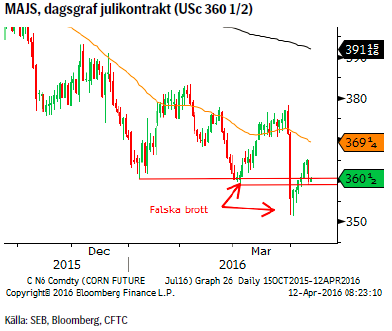 Givet hur negativt marknaden reagerade på USDA’s (US department of agriculture) rapport om prognosticerad planteringsareal för våren 2016 så är det ytterst intressant att notera att sedan rapporten släpptes så har priset sakta men säkert återhämtat sig. Dessutom så är lagren från föregående skörd fortfarande rekordstora. För att spä på den negativa bilden ytterligare så noterar vi att den korta nettopositioneringen ökade kraftigt förra veckan (många nya korta positioner och stängning av långa dito). Då är det inte desto mindre intressant att priset nu återtestar det tidigare huvudstödet. Håller detta så bör föregående rekyltopp ligga inom räckhåll.
Givet hur negativt marknaden reagerade på USDA’s (US department of agriculture) rapport om prognosticerad planteringsareal för våren 2016 så är det ytterst intressant att notera att sedan rapporten släpptes så har priset sakta men säkert återhämtat sig. Dessutom så är lagren från föregående skörd fortfarande rekordstora. För att spä på den negativa bilden ytterligare så noterar vi att den korta nettopositioneringen ökade kraftigt förra veckan (många nya korta positioner och stängning av långa dito). Då är det inte desto mindre intressant att priset nu återtestar det tidigare huvudstödet. Håller detta så bör föregående rekyltopp ligga inom räckhåll.
Vår rekommendation BULL MAJS X4 S är fortfarande giltig (stopp under föregående botten).
OBSERVATIONER
- Rekordstora lager.
- Planer på ytterligare utökad odlingsareal för majs.
- Eftersom plantering normalt sker i april så återstår att se vad som faktiskt kommer i jorden (slutlig USDA rapport släpps i slutet av juni).
- El Niňo klingar nu av i snabb takt (ytvattnet i Still havet kallnar fort). Frågan är om/när La Niňja slår (medförande kallare och torrare väder i Nordamerika).
- Falska brott har en historisk tendens att frambringa rörelser i motsatt riktning.
REKOMMENDATION
- BULL MAJS X4 S
AKTUELLA REKOMMENDATIONER
[box]SEB Veckobrev Veckans råvarukommentar är producerat av SEB:s Commodities Sales desk och publiceras i samarbete och med tillstånd på Råvarumarknaden.se[/box]
KÄLLOR
Bloomberg, Reuters, SEB
VILLKOR
För varje enskilt certifikat/mini future finns Slutliga Villkor som anger de fullständiga villkoren. Slutliga Villkor finns tillgängligt på kurssidan för respektive certifikat/mini future på www.seb.se, Börs & finans, fliken Strukturerade placeringar.
RISKER
En sammanfattning av de risker som är förknippade med Börshandlade certifikat generellt finns i Produktbroschyren för respektive certifikat eller mini future som är tillgängligt på seb.se/cert respektive seb.se/mini. För en fullständig bild av riskerna behöver du ta del av SEB:s offentliggjorda Grundprospekt för Certifikat- och Warrantprogram som är publicerat på www.seb.se/cert respektive seb.se/mini.
DISCLAIMER
Detta marknadsföringsmaterial, framtaget av SEB:s Commodities Sales desk, har upprättats enbart i informationssyfte.
Även om innehållet är baserat på källor som SEB bedömt som tillförlitliga ansvarar SEB inte för fel eller brister i informationen. Den utgör inte oberoende, objektiv investeringsanalys och skyddas därför inte av de bestämmelser som SEB har infört för att förebygga potentiella intressekonflikter. Yttranden från SEB:s Commodities Sales desk kan vara oförenliga med tidigare publicerat material från SEB, då den senare hänvisas uppmanas du att läsa den fullständiga rapporten innan någon åtgärd vidtas.
Dokumentationen utgör inte någon investeringsrådgivning och tillhandahålls till dig utan hänsyn till dina investeringsmål. Du uppmanas att självständigt bedöma och komplettera uppgifterna i denna dokumentation och att basera dina investeringsbeslut på material som bedöms erforderligt. Alla framåtblickande uttalanden, åsikter och förväntningar är föremål för risker, osäkerheter och andra faktorer och kan orsaka att det faktiska resultatet avviker väsentligt från det förväntade. Historisk avkastning är ingen garanti för framtida resultat. Detta dokument utgör inte ett erbjudande att teckna några värdepapper eller andra finansiella instrument. SEB svarar inte för förlust eller skada – direkt eller indirekt, eller av vad slag det vara må – som kan uppkomma till följd av användandet av detta material eller dess innehåll.
Observera att det kan förekomma att SEB, dess ledamöter, dess anställda eller dess moder- och/eller dotterbolag vid olika tillfällen innehar, har innehaft eller kommer att inneha aktier, positioner, rådgivningsuppdrag i samband med corporate finance-transaktioner, investment- eller merchantbanking-uppdrag och/eller lån i de bolag/finansiella instrument som nämns i materialet.
Materialet är avsett för mottagaren, all spridning, distribuering mångfaldigande eller annan användning av detta meddelande får inte ske utan SEB:s medgivande. Materialet riktar sig inte till personer vars medverkan kräver ytterligare prospekt, registrerings- eller andra åtgärder än vad som följer av svensk rätt. Det åligger var och en att iaktta sådana restriktioner. Materialet får inte distribueras i eller till land där distribution kräver ovan nämnda åtgärder eller strider mot reglering i sådant land. Materialet riktar sig således inte till fysiska eller juridiska personer hemmahörande i USA eller i något annat land där publicering eller tillhandahållande av materialet är förbjudet eller strider mot tillämpliga bestämmelser i landet.
Oaktat detta får SEB tillåta omfördelning av materialet till utvald tredje part i enlighet med gällande avtal. Materialet får inte spridas till fysiska eller juridiska personer som är medborgare eller har hemvist i ett land där sådan spridning är otillåten enligt tillämplig lag eller annan bestämmelse.
Skandinaviska Enskilda Banken AB (publ) är ett publikt aktiebolag och står under tillsyn av Finansinspektionen samt de lokala finansiella tillsynsmyndigheter i varje jurisdiktionen där SEB har filial eller dotterbolag.
Analys
Brent crude set to dip its feet into the high $50ies/b this week

Parts of the Brent crude curve dipping into the high $50ies/b. Brent crude fell 2.3% over the week to Friday. It closed the week at $61.29/b, a slight gain on the day, but also traded to a low of $60.14/b that same day and just barely avoided trading into the $50ies/b. This morning it is risk-on in equities which seems to help industrial metals a little higher. But no such luck for oil. It is down 0.8% at $60.8/b. This week looks set for Brent crude to dip its feet in the $50ies/b. The Brent 3mth contract actually traded into the high $50ies/b on Friday.

The front-end backwardation has been on a weakening foot and is now about to fully disappear. The lowest point of the crude oil curve has also moved steadily lower and lower and its discount to the 5yr contract is now $6.8/b. A solid contango. The Brent 3mth contract did actually dip into the $50ies/b intraday on Friday when it traded to a low point of $59.93/b.
More weakness to come as lots of oil at sea comes to ports. Mid-East OPEC countries have boosted exports along with lower post summer consumption and higher production. The result is highly visibly in oil at sea which increased by 17 mb to 1,311 mb over the week to Sunday. Up 185 mb since mid-August. On its way to discharge at a port somewhere over the coming month or two.
Don’t forget that the oil market path ahead is all down to OPEC+. Remember that what is playing out in the oil market now is all by design by OPEC+. The group has decided that the unwind of the voluntary cuts is what it wants to do. In a combination of meeting demand from consumers as well as taking back market share. But we need to remember that how this plays out going forward is all at the mercy of what OPEC+ decides to do. It will halt the unwinding at some point. It will revert to cuts instead of unwind at some point.
A few months with Brent at $55/b and 40-50 US shale oil rigs kicked out may be what is needed. We think OPEC+ needs to see the exit of another 40-50 drilling rigs in the US shale oil patches to set US shale oil production on a path to of a 1 mb/d year on year decline Dec-25 to Dec-26. We are not there yet. But a 2-3 months period with Brent crude averaging $55/b would probably do it.
Oil on water increased 17 mb over the week to Sunday while oil in transit increased by 23 mb. So less oil was standing still. More was moving.

Crude oil floating storage (stationary more than 7 days). Down 11 mb over week to Sunday

The lowest point of the Brent crude oil curve versus the 5yr contract. Weakest so far this year.

Crude oil 1mth to 3mth time-spreads. Dubai held out strongly through summer, but then that center of strength fell apart in late September and has been leading weakness in crude curves lower since then.

Analys
Crude oil soon coming to a port near you

Rebounding along with most markets. But concerns over solidity of Gaza peace may also contribute. Brent crude fell 0.8% yesterday to $61.91/b and its lowest close since May this year. This morning it is bouncing up 0.9% to $62.5/b along with a softer USD amid positive sentiment with both equities and industrial metals moving higher. Concerns that the peace in Gaza may be less solid than what one might hope for also yields some support to Brent. Bets on tech stocks are rebounding, defying fears of trade war. Money moving back into markets. Gold continues upwards its strong trend and a softer dollar helps it higher today as well.

US crude & products probably rose 5.6 mb last week (API) versus a normal seasonal decline of 2.4 mb. The US API last night partial and thus indicative data for US oil inventories. Their data indicates that US crude stocks rose 7.4 mb last week, gasoline stocks rose 3.0 mb while Distillate stocks fell 4.8 mb. Altogether an increase in commercial crude and product stocks of 5.6 mb. Commercial US crude and product stocks normally decline by 2.4 mb this time of year. So seasonally adjusted the US inventories rose 8 mb last week according to the indicative numbers by the API. That is a lot. Also, the counter seasonal trend of rising stocks versus normally declining stocks this time of year looks on a solid pace of continuation. If the API is correct then total US crude and product stocks would stand 41 mb higher than one year ago and 6 mb higher than the 2015-19 average. And if we combine this with our knowledge of a sharp increase in production and exports by OPEC(+) and a large increase in oil at sea, then the current trend in US oil inventories looks set to continue. So higher stocks and lower crude oil prices until OPEC(+) switch to cuts. Actual US oil inventory data today at 18:00 CET.
US commercial crude and product stocks rising to 1293 mb in week 41 if last nights indicative numbers from API are correct.

Crude oil soon coming to a port near you. OPEC has lifted production sharply higher this autumn. At the same time demand for oil in the Middle-East has fallen as we have moved out of summer heat and crude oil burn for power for air-conditioning. The Middle-East oil producers have thus been able to lift exports higher on both accounts. Crude oil and condensates on water has shot up by 177 mb since mid-August. This oil is now on its way to ports around the world. And when they arrive, it will likely help to lift stocks onshore higher. That is probably when we will lose the last bit of front-end backwardation the the crude oil curves. That will help to drive the front-month Brent crude oil price down to the $60/b line and revisit the high $50ies/b. Then the eyes will be all back on OPEC+ when they meet in early November and then again in early December.
Crude oil and condensates at sea have moved straight up by 177 mb since mid-August as OPEC(+) has produced more, consumed less and exported more.

Analys
The Mid-East anchor dragging crude oil lower

When it starts to move lower it moves rather quickly. Gaza, China, IEA. Brent crude is down 2.1% today to $62/b after having traded as high as $66.58/b last Thursday and above $70/b in late September. The sell-off follows the truce/peace in Gaze, a flareup in US-China trade and yet another bearish oil outlook from the IEA.

A lasting peace in Gaze could drive crude oil at sea to onshore stocks. A lasting peace in Gaza would probably calm down the Houthis and thus allow more normal shipments of crude oil to sail through the Suez Canal, the Red Sea and out through the Bab-el-Mandeb Strait. Crude oil at sea has risen from 48 mb in April to now 91 mb versus a pre-Covid normal of about 50-60 mb. The rise to 91 mb is probably the result of crude sailing around Africa to be shot to pieces by the Houthis. If sailings were to normalize through the Suez Canal, then it could free up some 40 mb in transit at sea moving onshore into stocks.
The US-China trade conflict is of course bearish for demand if it continues.
Bearish IEA yet again. Getting closer to 2026. Credibility rises. We expect OPEC to cut end of 2025. The bearish monthly report from the IEA is what it is, but the closer we get to 2026, the more likely the IEA is of being ball-park right in its outlook. In its monthly report today the IEA estimates that the need for crude oil from OPEC in 2026 will be 25.4 mb/d versus production by the group in September of 29.1 mb/d. The group thus needs to do some serious cutting at the end of 2025 if it wants to keep the market balanced and avoid inventories from skyrocketing. Given that IEA is correct that is. We do however expect OPEC to implement cuts to avoid a large increase in inventories in Q1-26. The group will probably revert to cuts either at its early December meeting when they discuss production for January or in early January when they discuss production for February. The oil price will likely head yet lower until the group reverts to cuts.
Dubai: The Mid-East anchor dragging crude oil lower. Surplus emerging in Mid-East pricing. Crude oil prices held surprisingly strong all through the summer. A sign and a key source of that strength came from the strength in the front-end backwardation of the Dubai crude oil curve. It held out strong from mid-June and all until late September with an average 1-3mth time-spread premium of $1.8/b from mid-June to end of September. The 1-3mth time-spreads for Brent and WTI however were in steady deterioration from late June while their flat prices probably were held up by the strength coming from the Persian Gulf. Then in late September the strength in the Dubai curve suddenly collapsed. Since the start of October it has been weaker than both the Brent and the WTI curves. The Dubai 1-3mth time-spread now only stands at $0.25/b. The Middle East is now exporting more as it is producing more and also consuming less following elevated summer crude burn for power (Aircon) etc.
The only bear-element missing is a sudden and solid rise in OECD stocks. The only thing that is missing for the bear-case everyone have been waiting for is a solid, visible rise in OECD stocks in general and US oil stocks specifically. So watch out for US API indications tomorrow and official US oil inventories on Thursday.
No sign of any kind of fire-sale of oil from Saudi Arabia yet. To what we can see, Saudi Arabia is not at all struggling to sell its oil. It only lowered its Official Selling Prices (OSPs) to Asia marginally for November. A surplus market + Saudi determination to sell its oil to the market would normally lead to a sharp lowering of Saudi OSPs to Asia. Not yet at least and not for November.
The 5yr contract close to fixed at $68/b. Of importance with respect to how far down oil can/will go. When the oil market moves into a surplus then the spot price starts to trade in a large discount to the 5yr contract. Typically $10-15/b below the 5yr contract on average in bear-years (2009, 2015, 2016, 2020). But the 5yr contract is usually pulled lower as well thus making this approach a moving target. But the 5yr contract price has now been rock solidly been pegged to $68/b since 2022. And in the 2022 bull-year (Brent spot average $99/b), the 5yr contract only went to $72/b on average. If we assume that the same goes for the downside and that 2026 is a bear-year then the 5yr goes to $64/b while the spot is trading at a $10-15/b discount to that. That would imply an average spot price next year of $49-54/b. But that is if OPEC doesn’t revert to cuts and instead keeps production flowing. We think OPEC(+) will trim/cut production as needed into 2026 to prevent a huge build-up in global oil stocks and a crash in prices. But for now we are still heading lower. Into the $50ies/b.
-

 Nyheter4 veckor sedan
Nyheter4 veckor sedanOPEC+ missar produktionsmål, stöder oljepriserna
-

 Nyheter2 veckor sedan
Nyheter2 veckor sedanGoldman Sachs höjer prognosen för guld, tror priset når 4900 USD
-

 Nyheter3 veckor sedan
Nyheter3 veckor sedanBlykalla och amerikanska Oklo inleder ett samarbete
-

 Nyheter3 veckor sedan
Nyheter3 veckor sedanGuld nära 4000 USD och silver 50 USD, därför kan de fortsätta stiga
-

 Analys4 veckor sedan
Analys4 veckor sedanAre Ukraine’s attacks on Russian energy infrastructure working?
-
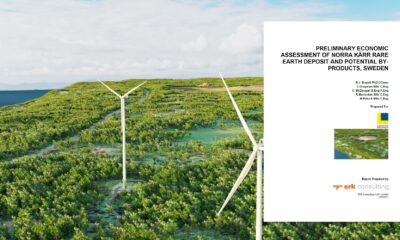
 Nyheter2 veckor sedan
Nyheter2 veckor sedanLeading Edge Materials är på rätt plats i rätt tid
-

 Nyheter3 veckor sedan
Nyheter3 veckor sedanEtt samtal om guld, olja, koppar och stål
-

 Nyheter2 veckor sedan
Nyheter2 veckor sedanNytt prisrekord, guld stiger över 4000 USD


